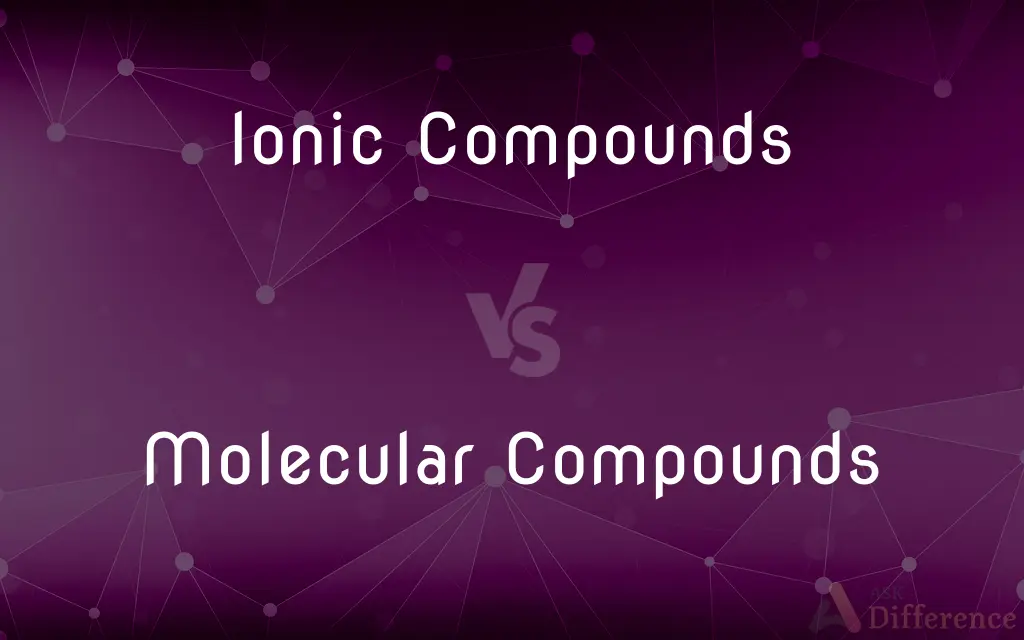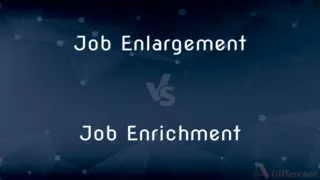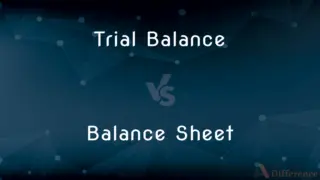Ionic Compounds vs. Molecular Compounds — What's the Difference?
By Tayyaba Rehman — Published on October 30, 2023
Ionic Compounds form when metal and nonmetal atoms transfer electrons, resulting in charged ions, while Molecular Compounds consist of nonmetal atoms sharing electrons, forming molecules.

Difference Between Ionic Compounds and Molecular Compounds
Table of Contents
ADVERTISEMENT
Key Differences
At the core of chemistry lie compounds, substances formed when two or more elements chemically combine. Ionic Compounds typically originate when metal atoms lose electrons, becoming positively charged ions, and nonmetal atoms gain electrons, becoming negatively charged ions. These oppositely charged ions attract, forming the compound. Contrastingly, Molecular Compounds form when nonmetal atoms come together, sharing electrons to complete their outer electron shells, resulting in discrete molecules.
In an Ionic Compound, the electrostatic attraction between the positive and negative ions holds the structure together. These compounds often exhibit high melting and boiling points due to these strong ionic bonds. On the other hand, Molecular Compounds often have lower melting and boiling points because they're held together by weaker forces, like covalent bonds between atoms and intermolecular forces between molecules.
When considering solubility and conductivity, Ionic Compounds generally dissolve in water, breaking into individual ions, which makes these solutions conductive. In contrast, Molecular Compounds might dissolve in water but usually don't produce charged particles, making most of their aqueous solutions non-conductive.
From a nomenclature perspective, naming varies between the two. Ionic Compounds typically take the name of the metal ion followed by the nonmetal ion with an "-ide" suffix. In the realm of Molecular Compounds, prefixes indicate the number of each atom present, followed by the first element's name and then the second's with an "-ide" ending.
Lastly, Ionic Compounds often form crystalline structures, given the orderly arrangement of their ions in a repeating pattern. Molecular Compounds, however, don't usually form these large crystal lattices, as their discrete molecules come together in more random arrangements.
ADVERTISEMENT
Comparison Chart
Bonding
Formed by transfer of electrons.
Formed by sharing of electrons.
Components
Metal and nonmetal ions.
Nonmetal atoms.
Physical State
Often solid and crystalline at room temperature.
Can be solid, liquid, or gas at room temperature.
Conductivity in Solution
Conductive when dissolved or molten.
Usually non-conductive.
Melting/Boiling Points
Generally high.
Generally low.
Compare with Definitions
Ionic Compounds
Consist of positively and negatively charged ions.
In the formation of Ionic Compounds like magnesium oxide, magnesium becomes positively charged and oxygen negatively charged.
Molecular Compounds
Consist of discrete molecules held by covalent bonds.
Methane is a Molecular Compound where four hydrogen atoms are covalently bonded to a carbon atom.
Ionic Compounds
Formed by electrostatic attraction between ions.
Sodium chloride is an example of Ionic Compounds where sodium and chloride ions are attracted to each other.
Molecular Compounds
Named using prefixes to indicate atom numbers.
In naming Molecular Compounds, carbon dioxide indicates two oxygen atoms bonded to one carbon atom.
Ionic Compounds
Generally form crystalline solids.
The orderly arrangement of ions in Ionic Compounds results in substances like copper(II) sulfate forming crystals.
Molecular Compounds
Non-conductive in aqueous solutions.
Sugar, a Molecular Compound, does not conduct electricity when dissolved in water.
Ionic Compounds
Exhibit high melting and boiling points.
The strong ionic bonds in Ionic Compounds like potassium bromide give it a high melting point.
Molecular Compounds
Exhibit lower melting and boiling points compared to ionic compounds.
Due to their weaker intermolecular forces, Molecular Compounds like carbon dioxide have lower boiling points.
Ionic Compounds
Result from electron transfer between metal and nonmetal.
Calcium fluoride is one of the Ionic Compounds formed when calcium donates electrons to fluorine.
Molecular Compounds
Formed by nonmetals sharing electrons.
Water is one of the Molecular Compounds where two hydrogen atoms share electrons with an oxygen atom.
Common Curiosities
What are Ionic Compounds?
Ionic Compounds are substances formed by the electrostatic attraction between positively and negatively charged ions, typically metal and nonmetal ions.
Why do Ionic Compounds conduct electricity in solution?
Ionic Compounds dissociate into charged ions in solution, facilitating the flow of electric current.
Can Molecular Compounds conduct electricity?
Typically, Molecular Compounds don't conduct electricity because they don't produce charged particles in solution.
Are all Ionic Compounds solid at room temperature?
Most Ionic Compounds are solid due to their strong ionic bonds, but there may be exceptions.
How are Molecular Compounds named?
Molecular Compounds use prefixes to denote the number of each atom present, followed by the base name of the elements with an "-ide" suffix for the second element.
Which compounds typically dissolve better in water, Ionic or Molecular?
Ionic Compounds generally dissolve better in water, but solubility can vary among both types.
How do Molecular Compounds differ from Ionic Compounds?
Molecular Compounds are formed by nonmetal atoms sharing electrons, creating molecules, whereas Ionic Compounds result from ion formation via electron transfer.
Why do Ionic Compounds usually have higher melting points than Molecular Compounds?
The strong ionic bonds in Ionic Compounds require more energy to break than the weaker forces in Molecular Compounds.
How do the structures of the two compound types differ?
Ionic Compounds form crystalline lattices, while Molecular Compounds comprise discrete molecules.
What kind of elements form Molecular Compounds?
Nonmetals typically form Molecular Compounds by sharing electrons.
Why don't Molecular Compounds usually form crystals like Ionic Compounds?
Molecular Compounds consist of discrete molecules with weaker forces between them, making crystalline structure formation less common.
Which compound type is more common in organic chemistry?
Molecular Compounds are more prevalent in organic chemistry, as they primarily involve carbon and other nonmetals bonded covalently.
Do all Molecular Compounds have low melting points?
While many Molecular Compounds have low melting points, there are exceptions based on the type and strength of the intermolecular forces present.
Can Molecular Compounds form between a metal and a nonmetal?
Typically, metals and nonmetals form Ionic Compounds; Molecular Compounds usually involve nonmetals only.
What happens when an Ionic Compound is placed in water?
Many Ionic Compounds dissociate into their individual ions when placed in water.
Share Your Discovery

Previous Comparison
Job Enlargement vs. Job Enrichment
Next Comparison
Trial Balance vs. Balance SheetAuthor Spotlight
Written by
Tayyaba RehmanTayyaba Rehman is a distinguished writer, currently serving as a primary contributor to askdifference.com. As a researcher in semantics and etymology, Tayyaba's passion for the complexity of languages and their distinctions has found a perfect home on the platform. Tayyaba delves into the intricacies of language, distinguishing between commonly confused words and phrases, thereby providing clarity for readers worldwide.












































